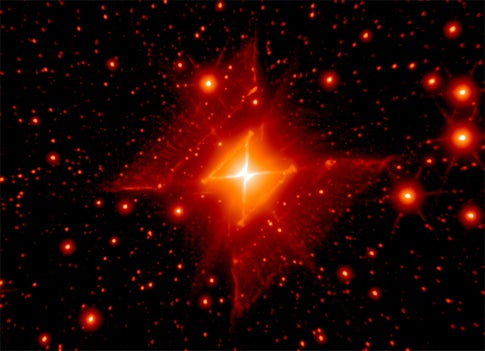Astronomers announced the arrival of a new member in the pantheon of exotically beautiful celestial objects. Christened the “Red Square” by Peter Tuthill, leader of the team, the image was compiled with data from the 200-inch Hale Telescope at Palomar Observatory, owned and operated by the California Institute of Technology, and the Keck-2 Telescope atop Mauna Kea, Hawaii.
The findings will appear April 13 in the journal Science in an article titled “A symmetric bipolar nebula around MWC 922,” written by Tuthill from the University of Sydney and James Lloyd of Cornell University.
“Discoveries as beautiful — and interesting — as this one don’t come around very often in astronomy.” says Tuthill. “And it took some of the world’s most advanced telescopes, together with a good dose of luck, to find this jewel hidden among the myriad stars in the galaxy.”
“The key to finding it was in the revolutionary new imaging technology of adaptive optics, which acts like a myopia cure for a telescope,” agrees Lloyd. “Startlingly clear images capable of revealing objects like this are now possible without the blurring.”
The pair studied a hot star called MWC 922 in the constellation Serpens (the serpent mythologically associated with the origin of medicine). The image shown here combines data taken in near-infrared light (1.6 microns) and shows a region 30.8 arc seconds on a side around MWC 922. As the outer periphery of the nebula is very faint compared to the core, the image has been processed and sharpened to display the full panoply of detail and structure.
“The thing that really takes your breath away is the astonishing degree of symmetry within the intricate linear forms,” says Tuthill. “If you fold things across the principle diagonal axis, you get an almost perfect reflection symmetry. This makes the Red Square nebula the most symmetrical object of comparable complexity ever imaged.”
The overall architecture of twin opposed conical cavities (commonly known in astronomy as a “bipolar nebula”) is seen to be adorned with a remarkable sequence of sharply defined linear rungs or bars. This series of rungs and conical surfaces lie nested, one within the next, down to the heart of the system, where the hyperbolic bicone surfaces are crossed by a dark lane running across the principle axis.
One particularly fascinating feature visible in the images is a series of faint radial spokes, like teeth of a comb, pointing away from the center. “Structures such as this are rarely seen in nebulae, and the high degree of regularity in this case may point to the intriguing possibility that these bands are shadows cast by periodic ripples or waves on the surface of an inner disk close to the star at the heart of the system,” says Lloyd.
But the most compelling and important implication for astronomy comes from the three-dimensional structure implied by the Red Square images.
“If you can really get a mental grasp of the three-dimensional geometry implied by the Red Square images,” says Tuthill, “then it is fascinating to take a second look at one of the most famous astronomical images of them all: SN1987A.” An image of the supernova as seen by the Hubble Space Telescope is to the right, showing the beautiful and unexpected ring system revealed around SN1987A — the only naked-eye supernova since the discovery of the telescope.
“We are not saying that the star MWC 922 at the heart of the Red Square is about to explode as a supernova.” says Lloyd, “But we’re not ruling it out either, and if it did it would certainly put on quite a show as it kindles the outer reaches of its nebula.”
Whatever the fate of the central star, the remarkable series of bars seen in the Red Square make it the best astrophysical laboratory yet discovered for studying the physics of generating the mysterious sharp polar-ring systems like that around SN1987A.
According to Tuthill, “This is just the beginning — a system as complex and fascinating as this is bound to keep us guessing for years to come.”










